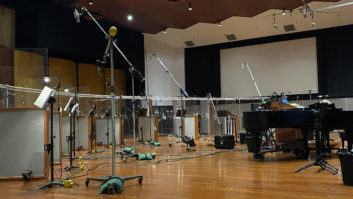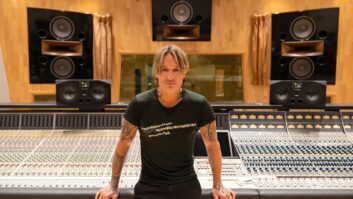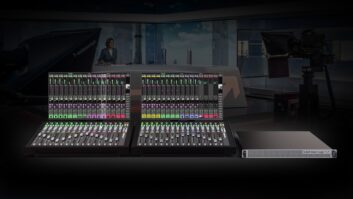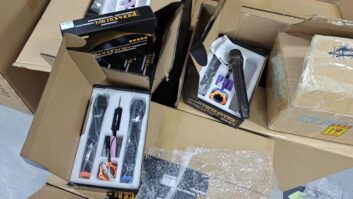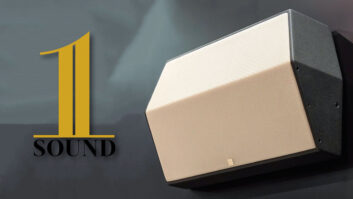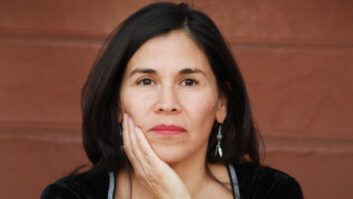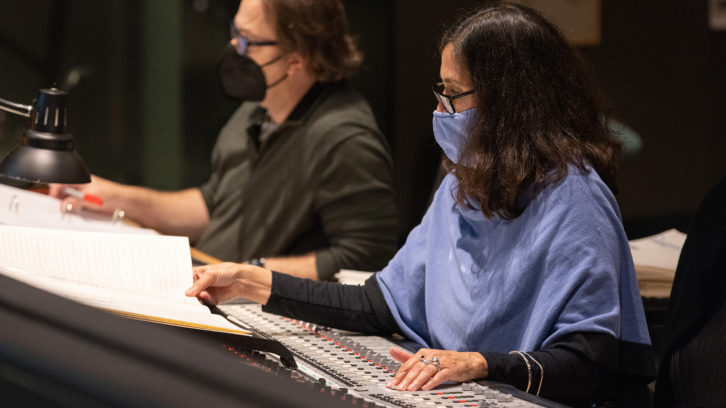
Los Angeles, CA (April 7, 2022)—Tiple. Gaita. Cununo. Arpa llanera. Any logophile can appreciate composer Germaine Franco’s list of instruments contributing Latin American flavors to the score on Walt Disney Animation’s 60th feature film, Encanto.
Directed by Jared Bush and Byron Howard, Encanto is set in the heart of Colombia, and Franco’s score incorporates a plethora of sounds, musical styles and rhythms from that country. But she couldn’t travel to Colombia for inspiration—as she’d traveled to Mexico before working on Disney/Pixar’s Coco—because the Covid pandemic had the world locked down in 2020, when she started work. Instead, Franco brought Colombia to her.
She selected several Colombian guitars, like the tiple, a twangy-sounding 12-string from the Andes, with strings grouped in four tripled courses; each course has three closely spaced strings meant to be played together. The score also features a bandola andina, a small pear-shaped guitar with six doubled or tripled courses, and a Colombian cuatro, a small, four-string guitar similar to a ukulele in D-tuning with the B string tuned an octave lower. She kept going, bringing in a harp commonly played in Colombia and Venezuela—the arpa llanera.
“My friend, composer John Powell, sampled the arpa llanera for me in his beautiful live room,” she says. “We sampled short notes, long notes and tremolos at various dynamics with multiple round robins. Later, we turned them into 5.1 Sampler Instruments in Logic Pro.”
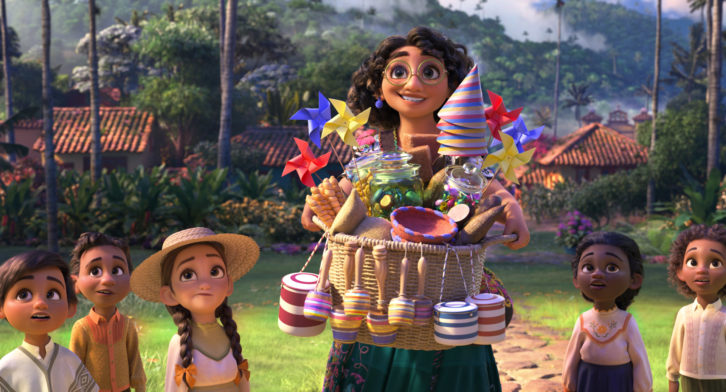
For percussion, Franco incorporated a variety of Latin American and Afro-Colombian drums, including cununos (conical-shaped, closed-bottom hand drums with animal-hide drum heads), tamboras (snare-sized, two-headed hand drums), and bombos (processional drums made from hollowed tree trunks with a goat-hide drum head, typically played with drum sticks). Franco’s score includes a Latin American flute called a gaita that’s very specific to Colombia. “It’s beautiful. It sounds like a bird. [World winds virtuoso] Pedro Eustache played the parts wonderfully!” she notes.
Her score also features a marimba de chonta—a marimba only found in Colombia because the bars are made from “chonta,” a type of palm tree native to Ecuador and Colombia’s Pacific Coast. “I had one made by a luthier and shipped to me. It’s not on every single cue, just a few specific ones,” says Franco.
She hired a Colombian choir of 12 singers: “We did the session in Colombia, which I attended remotely. That took many hours to record, but it was fantastic.”
Guild of Music Supervisors Announce 12th Annual Award Winners
In cues like “Meet La Familia” and “Las Hermanas Pelean,” there’s also a button accordion, performed by Colombia-native accordionist Cristian” Camilo Peña, who plays in Carlos Vives’s band, and Enrique Martinez of Los Angeles.
“The accordion is in the cues which feature the cumbia rhythm for Mirabel, the protagonist’s theme,” Franco explains. “The cumbia is a style of music which originated in Colombia and has been adopted in many Latin American countries.”
The influence of Colombian musical styles and rhythms—cumbia, mapalé, bullerengue, joropo, chande—coupled with Franco’s unique orchestration, were integral to the score’s sound.
GOING BIG ON THE STAGE
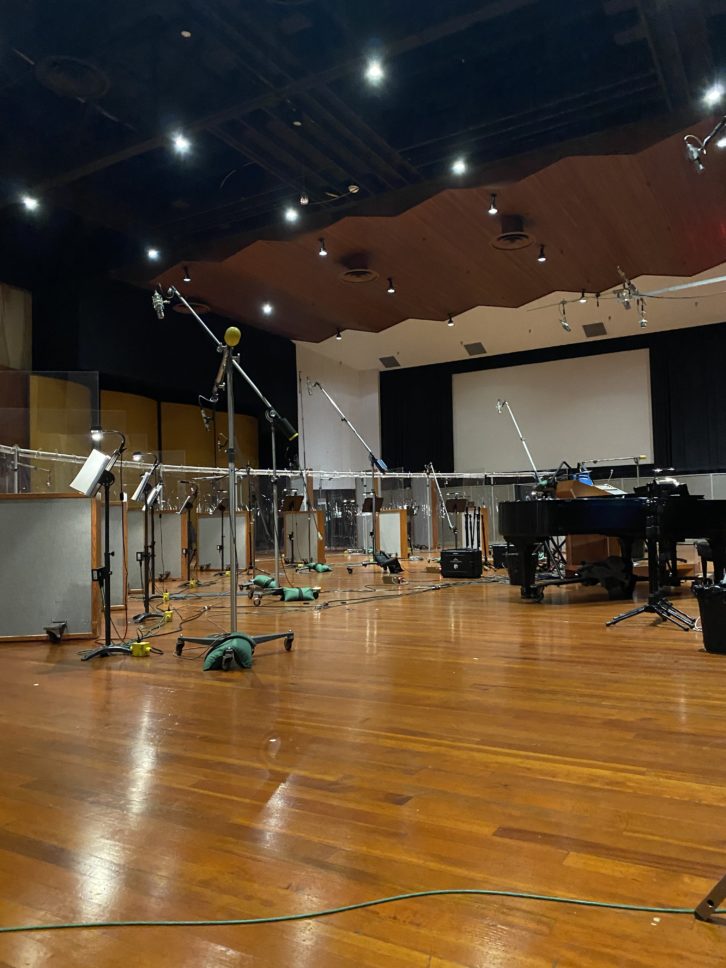
Once Franco’s demo mockups, typically a mixture of MIDI programming and her own live audio recordings, were approved by directors Bush and Howard, she worked with a team of orchestrators and music preparation musicians led by Disney’s Booker White and supervising orchestrators David Giuli and John Ashton Thomas.
Franco produced all of the orchestral sessions for both the score and the songs, written by Lin-Manuel Miranda. Greg Hayes recorded the orchestra for the scoring sessions at the Newman Scoring Stage at Fox Studios in Los Angeles, and the choir session at The Eastwood Scoring Stage on the Warner Bros. lot in Burbank.
Franco performs on all of her scores. She briefly left her producing post on Encanto to join a group of L.A.’s finest session musicians in the live room to play snare drum and marimba de chonta for cues like “El Camino de Mirabel,” “Antonio’s Room” and “La Cumbia De Mirabel.”
“I wound up jumping in there with the session players because Jared [Bush] made a bet with me that I would have to play on the score if he attended some of the sessions in person,” she says with a small laugh. “I was the lead snare drummer in my high school marching band, so it was fun to go back and play the snare on the score.”
Because Encanto’s score was recorded during the pandemic, the music team had to deal with Covid safety restrictions, like limiting the number of players in each session, planning out properly spaced seating arrangements for players, and separating unmasked players from masked players. The latter was a challenge for the strings and woodwinds in particular.
“The woodwinds and strings are tuning to each other so there can be tuning issues if they’re not together in the same room,” Franco explains. “Players want to sit next to each other, to play off of each other and create the collective sound of the orchestra. Instead, they were spaced further apart, so the players had to adapt to the new recording process as an ensemble by listening through their headphones.”
In terms of the choir, Franco says, “We were going to go for 30 singers, but everyone had to be kept six feet apart, so that limited the number to 22. The stage recording crew was thorough. They made dividers out of shower curtains and gobos to keep everyone separated and safe.”
Harpist Katie Kirkpatrick performed all the harp parts that Franco wrote using the arpa llanera samples in her MIDI score demos. An ensemble of seven Latin percussionists, as well as an entire orchestral percussion section, performed on the score. Franco also invited several Colombia-born session musicians, including percussionists J.D. Perez and saxophonist/clarinetist Justo Almario.
“Alvin Wee provided additional recording for the soloist sessions at The Village Studios, and then mixed the score. Greg [Hayes] then created the 5.1 stems that were sent to the re-recording mixers on the dub stage,” says Franco. David E. Fluhr, CAS (dialog/music re-recording mixer) used those stems to craft Encanto’s Dolby Atmos film mix, alongside effects re-recording mixer Gabriel Guy.
CLICK THROUGH TO PART 2!
